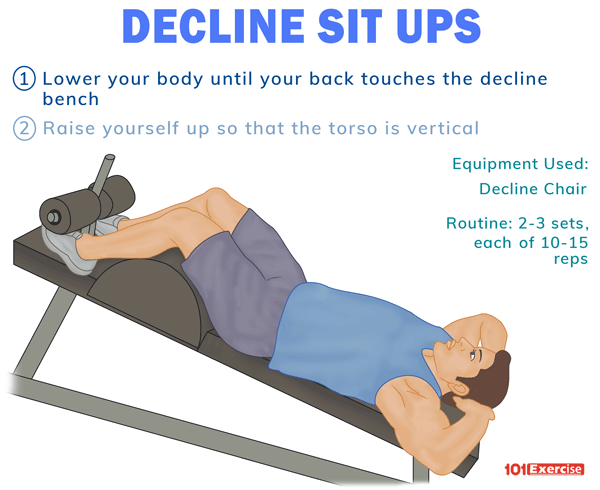Decline Sit-Ups
Table of Contents:
Exercise Information
- Alternative Names: Decline bench sit-ups
- Type: Strength
- Experience Level: Intermediate, advanced
- Equipment: Bodyweight, decline bench
- Muscles Targeted: Abs, chest, hips, lower back, neck
- Mechanics: Isolation
- Average Number of Sets: 2-3 with 10-15 reps each
- Variations: None
- Alternative: Weighted decline sit-ups, twisting decline dumbbell sit-ups
The decline sit-ups have now become a popular exercise and included in almost every gym sessions by trainers. Although an average person might think that the decline version is quite similar to the basic sit-ups, it is more complex than the regular sit-ups because of the increase in the range of motion and force created by the decline angle of the bench. Therefore, this exercise is suited for experienced trainees who know how to execute the movement properly.
Decline Sit-Ups Exercise Information
- Alternative Names: Decline bench sit-ups
- Type: Strength
- Experience Level: Intermediate, advanced
- Equipment: Bodyweight, decline bench
- Muscles Targeted: Abs, chest, hips, lower back, neck
- Mechanics: Isolation
- Average Number of Sets: 2-3 with 10-15 reps each
- Variations: None
- Alternative: Weighted decline sit-ups, twisting decline dumbbell sit-ups
How to do Decline Sit-Ups
Before starting the exercise, set the bench to a decline angle of 30-45 degrees. If you increase the angle, the training will become more challenging. While you need to keep your hands behind your head throughout the movement, you may also keep your arms crossed across the chest to make it easier for you.
Decline Bench Sit-Ups Tips
- Make sure your back does not touch the bench while leaning back.
- Instead of going too far up, raise yourself until your torso is vertical.
Variations
- Weighted Decline Sit-Ups: Performed by holding a dumbbell, weight plate, or medicine ball for extra resistance and intensity.
- Twisting Decline Dumbbell Sit-Ups: Done with a pair of dumbbells in your hands, involves bringing your alternating arms forward towards your knee after you pull yourself up from the lower position.

